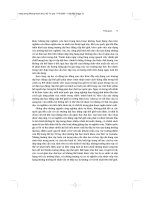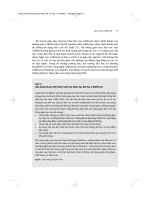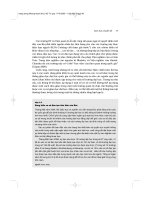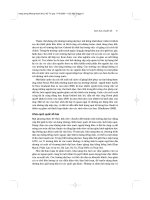The chanllenges of teaching english at primary schools a survey in one province = những thách thức trong việc dạy tiếng anh tại các trường tiểu học khảo sát tại một tỉnh
Bạn đang xem bản rút gọn của tài liệu. Xem và tải ngay bản đầy đủ của tài liệu tại đây (1.07 MB, 54 trang )
VIET NAM NATIONAL UNIVERSITY, HA NOI
UNIVERSITY OF LANGUAGES & INTERNATIONAL STUDIES
FACULTY OF POST – GRADUATE STUDIES
*****************
TRAN THI GIANG
THE CHALLENGES OF TEACHING ENGLISH
AT PRIMARY SCHOOLS: A SURVEY IN ONE PROVINCE
(Những thách thức trong việc dạy tiếng Anh
tại các trường tiểu học: Khảo sát tại một tỉnh)
M.A. Thesis
Field: English Teaching Methodology
Code: 8140231.01
Hanoi – 2019
VIET NAM NATIONAL UNIVERSITY, HA NOI
UNIVERSITY OF LANGUAGES & INTERNATIONAL STUDIES
FACULTY OF POST – GRADUATE STUDIES
*****************
TRAN THI GIANG
THE CHALLENGES OF TEACHING ENGLISH
AT PRIMARY SCHOOLS: A SURVEY IN ONE PROVINCE
(Những thách thức trong việc dạy tiếng Anh
tại các trường tiểu học: Khảo sát tại một tỉnh)
M.A. Thesis
Field: English Teaching Methodology
Code: 8140231.01
Supervisor: Assoc. Prof.Dr.Le Van Canh
Hanoi – 2019
DECLARATION
I, Tran Thi Giang, declare that the thesis entitled “The challenges of teaching
English at primary schools: A survey in one province” reports the result of the
study conducted by myself. The thesis is submitted to College of Foreign
Languages-Vietnam National University for Degree of Master in TESOL. It has
not been published anywhere.
Signature
Student
Tran Thi Giang
i
ACKNOWLEDGEMENTS
First of all, I would like to express my sincere gratitude to those who gave
me the possibility to complete this thesis. Furthermore, I am grateful to his close
guidance and generous help, which have been great encouragement to me during
the process of writing and completion of thesis.
I wish to take this opportunity to express my heart-felt thanks to Mr. Le Van
Canh whose lectures provided me with a great deal of pedagogical knowledge in
language teaching. His initial suggestion inspired me conduct this study.
I am deeply indebted to the teachers who were willing to give me information
via survey questionnaire, face-to-face and facebook interview. My thanks also go to
my colleagues, officers in Ninh Binh Provincial DOET, who gave me favorable
condition of time for pursuing MA course and completing the research.
Last but not least, I would like to offer my deepest thanks to my family
whose affection and support enable me to complete this work.
ii
ABSTRACT
The research aimed to identify the challenges that faced teachers in
teaching English at the primary schools, the challenges learners encounter. Set
of questionnaire is designed and the survey is launched in primary schools in a
province. The samples of the study were 100 teachers from 100 public schools
throughout the province, interview with 8 selected teachers from districts, and
observational data collected in 10 schools. The results of the study indicated that
the low motivation and the shallow, negative, and passive teaching, learning
strategies lead to the low outcome. In addition, from the results of the study,
some pedagogical suggestions related to creating a classroom atmosphere,
praises and rewards, opportunities of success, activities and techniques, and
more learning strategies, are offered for teachers of English.
iii
LIST OF TABLES
Table 1
Teachers’ advantages in teaching
Table 3
Teachers' difficulties in teaching English at primary schools
Table 4
Teachers’ solutions to their difficulties
Table 5
Teachers’ proposals
iv
LIST OF APPREVIATION
MOET
Ministry of Education and Training
DOET
Department of Education and Training
PELT
Primary English Language Teaching
EBE
English Bilingual Education
PEFLTs
Primary English foreign language teachers
TESOL
Teaching English as a foreign language
v
TABLE OF CONTENTS
DECLARATION .................................................................................................. i
ACKNOWLEDGEMENTS ................................................................................ ii
ABSTRACT ........................................................................................................ iii
LIST OF TABLES.............................................................................................. iv
LIST OF APPREVIATION ............................................................................... v
TABLE OF CONTENTS ................................................................................... vi
PART 1: INTRODUCTION ............................................................................... 1
1. Rationale ........................................................................................................ 1
2. Significance of the study ............................................................................... 2
3. Aims of the study .......................................................................................... 3
4. Research methods .......................................................................................... 4
5. Participants .................................................................................................... 4
6. Scope of the study ......................................................................................... 4
7. Organization of the thesis .............................................................................. 4
PART 2: DEVELOPMENT ............................................................................... 6
CHAPTER 1: LITERATURE REVIEW .......................................................... 6
1.1. Teaching English to primary school children as a global phenomenon .......... 6
1.2. Challenges in teaching English to primary school learners. ...................... 7
1.3. How do young learners learn English? ...................................................... 8
1.4. Challenges on the part of teachers............................................................ 13
1.5. Previous studies on primary school English teaching in Vietnam ........... 16
1.6. Summary ................................................................................................. 18
CHAPTER 2: THE CONTEXT OF TEACHING ENGLISH TO
PRIMARY SCHOOL CHILDREN IN THE PROVINCE ........................... 19
2.1. English instruction to primary children in Vietnam ................................. 19
vi
2.1.1. Policy............................................................................................... 19
2.1.2. Implementation................................................................................ 20
2.1.3. The way forward ............................................................................. 20
2.2. Introduction to the province context of teaching-learning English at
primary schools. .............................................................................................. 21
2.3. Teachers and their background ................................................................ 22
2.4. Summary .................................................................................................. 23
CHAPTER 3: THE STUDY ............................................................................. 24
3.1.The data collection instruments ................................................................ 24
3.2.The participants ......................................................................................... 25
3.3.Data collection procedure ......................................................................... 25
3.4.Data analysis ............................................................................................. 26
3.5.Findings ..................................................................................................... 26
3.5.1. Teachers’ experience of English teaching at primary school level.27
3.5.2. Teachers’ self-judgement of training workshops they have attended. . 27
3.5.3. Teachers’ advantages in teaching .................................................. 28
3.5.4. Teachers’ difficulties in teaching at primary schools..................... 28
3.5.5. Teachers’ solutions to their difficulties........................................... 30
3.5.6. Teachers’ proposal ......................................................................... 31
3.5.7. Teachers’ performance in the classroom........................................ 32
CHAPTER 4: CONCLUSION ......................................................................... 39
REFERENCES .................................................................................................. 41
APPENDIX
vii
PART 1: INTRODUCTION
1. Rationale
English is the increasingly offered at primary level (Enever & Moon, 2009;
Nikolov, 2009b) because of the following major reasons:
(i). The widespread assumption that earlier language learning is better (Y.
Hu, 2007; Nunan, 2003).
(ii). The response to the ever-increasing demand for English as a result of
economic globalization (Enever & Moon, 2009; Gimenez, 2009; Hu, Y., 2007).
Such a demand leads to pressure on governments from international economic
forces to ensure there is an English-speaking workforce.
(iii). The pressure from parents in the national context who want their
children to benefit socially and economically from learning English (Brock-Utne
& Holmarsdottir, 2004; Enever & Moon, 2009; Gimenez, 2009).
In an effort to become more competitive in the global market, Vietnam, as
many other countries in South Asia, has declared English the dominant foreign
language to be taught in schools across the country. As a result, in the last 10
years, the government has launched out the project teaching and learning foreign
languages – Project 2020, in the 3321 decision, the primary curriculum has been
revised and emphasis has been given on learning English. English is being
taught in almost primary schools from grade 3 all over the country. The main
objectives of teaching English in primary level education in Viet Nam are to
enable students to understand simple commands, requests and instructions in
English and carry them out. The students can speak and converse in simple
English and also can read to comprehend the textbooks set for their age group
and level. They also write words, simple sentences, passages, paragraphs,
informal letters and numbers according to their age group and level.
1
Unfortunately many students, especially students of the rural primary schools
are unable to attain the primary English language competencies due to
prevailing challenges in our education system. A survey is intended to do at
primary schools in a province to find out: challenges that teachers, students
encounters; what strategies they use to deal with those challenges and how
effective they are.
Teaching English to primary children did not receive little concern in
Vietnam, it was introduced to grade 3 students. National and local education
professionals, now, have a more serious look at the situation. Teaching English
to primary children is by nature far different from teaching to other groups of
learner. Thus, if teachers are not qualified to work with primary children, they
may not be able to motivate the children to study, or to use appropriate, effective
tasks to develop students’ communicative competence.
As a foreign language specialist in a Provincial Department of Education
and Training, the author saw a great number of challenges of teaching English to
primary children in her province. To successfully manage the English teachinglearning throughout the province, the researcher feels the urge to study the
challenges perceived by the teachers so that some feasible solutions to the
problems can be employed.
2. Significance of the study
Since this study is concerned the researcher hope that it will contribute to
the province’s duty people a general review of difficulties in teaching English at
primary schools after some years to do the Decision 3321, therefore there will be
policies to help to solve the problems.
For the researcher: With the deputy of English Specialist in Teaching
English to primary school students of the province, the researcher can have
better understanding about the difficulties of teaching, learning English in
2
primary schools and can be the consultant for teachers, for schools, can propose
some methods to have better out come.
For the teacher: This study can support the teacher to develop their
teaching abilities. They can adjust strategies to teach the students. In order
students will be interested in learning process.
For the students: New teaching strategies can help to motivate students to
learn English better.
This study points out challenges of teaching English at primary schools.
Although the survey was conducted in one province, the author believes the
challenges are similar in other provinces throughout the country. Thus, the
results of the study will be of some contribution to education management
regarding teacher development and language policy implementation.
Professionally, the findings and comments of this study are believed to be
relevant to improving the primary English teachers’ quality in Vietnam in
general and in the province in particular. The study may be of great suggestions
for the enhancement of primary English education in Vietnam.
3. Aims of the study
This study aims to investigate challenges of teaching English at primary
schools as perceived by the teachers. To be more specific, the objectives of this
study are:
- To find out the challenges that English teachers at primary schools are
facing with.
- To explore the challenges in learning English that children at primary
schools are encountered.
- To suggest solutions to reduce the problems and challenges of teaching
English at primary schools.
These aims are formulated into 2 following research questions:
3
1. What challenges are teachers facing when teaching English at primary
schools?
2. What challenges do children at primary schools have in learning English?
4. Research methods
This study is a survey study. Three main instruments of data collection are:
- Questionnaire administers to 100 teachers of English from 100 primary
schools within the province to find out the challenges they are faced with as well
as the strategies they use to deal with those challenges.
- Interviews with selected teachers to gain more in-depth information
about issues raised in the questionnaires responses.
- Classroom observations to find out the challenges learners have in
learning English.
5. Participants
Participants are 100 teachers from 100 primary schools throughout the
province and their students. Data collected from questionnaires were analyzed
quantitatively. Data from interviews and class observation were qualitatively
analyzed into corresponding topics for triangulation and for answering questions.
6. Scope of the study
Dealing with challenges of all types is too broad for a study of this size.
Therefore, the focus of this study is to investigate some challenges relating to
professional supports that primary teachers receive from local and national level
in their teaching of English at primary schools.
7. Organization of the thesis
This minor thesis consists of four chapters.
The first part is the introduction which reveals the rationale, significance,
aims, methods, participants, scope and organization of the study.
4
The second part includes chapters. Chapter 1 is the literature review
centering on Teaching English to primary school children as a global
phenomenon, challenges in teaching English to primary school learners, how
do young learners learn English, challenges on the part of teachers, privious
study on primary school English teaching in Viet Nam and a brief
introduction of teaching English to primary students in Vietnam context.
Chapter 2 provides information about the research context which is the
teaching of English to primary school children in one province.
Chapter 3 presents the information about the study including the research
methodology, participants and research procedures, research findings and the
discussion of those findings.
Chapter 4 is the conclusion.
5
PART 2: DEVELOPMENT
CHAPTER 1: LITERATURE REVIEW
1.1. Teaching English to primary school children as a global phenomenon
With the belief that foreign languages prepare today’s youth for tomorrow’s
opportunities by supporting basic skills instruction, developing cross cultural
understanding and preparing the youth to enter the global market place, English
has become a worldwide language and is used as the medium of international
communication and is the language of professional advancement. It has become
the number one foreign language to be taught both inside and outside the formal
educational systems of many countries. The fact is that in most countries,
children are learning English at younger and younger ages. In many countries,
English is a compulsory subject in the early primary grades (Nikolov, 2009;
Pinter, 2006). In a recent survey of EYL teachers from 55 countries around the
world, Shin and Crandall (2011) 3 1 Teaching English to Young Learners found
that more than 50 percent of these countries introduced compulsory English
language courses by third grade. Even in countries where families may choose
the foreign language for their children to study, English is “overwhelmingly the
first choice” (Garton, Copland, & Burns, 2011, p. 5). The growing demand for
English, plus parents’ belief that English skills provide their children with a
better education and better employment opportunities, have led to an increase in
the number of EYL programs (Enever & Moon, 2009; Gimenez, 2009). As
English becomes the world’s lingua franca, countries all over the world have
adopted English language instruction as part of their education system. Many
countries begin at the primary level, and students are studying the language at
younger and younger ages (Jenkins, 2009).
6
1.2. Challenges in teaching English to primary school learners.
Moon (2000) argues that children are capable of learning foreign language
from any age providing that the right conditions are in place to enable young
learners to be successful. Some of the most important conditions are:
(1) Realistic aims/expectation and expected outcome
(2) Well-trained teachers fluent in English
(3) Age appropriate curricula and materials
(4) Appropriate assessment and monitoring
(5) Enough time
(6) Continuity and Transfer to secondary level
Concerning the effectiveness of language learning at primary level, Isabel
& Elisabeth (1997, p. 23) emphasized the following factors which are
considered to be of great importance for successful early language learning:
(1) Well-trained teachers (language competence and methodological skills)
(2) Well-organized in-service training
(3) Well-structured curriculum with adequate timetable
(4) Suitable and motivating materials
(5) Continuity of language learning within the primary school and from
primary to secondary stage
(6) Quality assurance measures
Considering all the above factors helps to identify the challenges. For over a
decade, a number of studies investigating early language programmer have been
conducted in various countries. Nikolov. M and Curtain. H (2000) summarized a
number of issues relating to teaching English to primary children around the world.
Through their collection, a concrete picture of teaching English to primary children
was formed with a number of similar issues among which the most popular ones
are related to teachers’ quality and continuity of the programmer.
7
1.3. How do young learners learn English?
With regard to primary school children, it is necessary to first specify that
children have both features of new beginners and the peculiar characteristics of
their age group, children have their own characteristics in learning foreign
languages. To achieve success in teaching English in primary schools, it is very
important to know the characteristics of students. Teachers should understand
young learners’ instincts, interests, cognizance, emotional aspects and especially
their characteristics. These issues play a crucial role in guiding teachers’
planning a lesson in an attempt to make sure that the young learners are
interested in and fully engaged in the whole process of learning.
According to Paradowski (2007, pp. 52-247) young learners possess the
following features:
Involuntary attention
Children
do
not
pay
attention
to
the
language
system.
They
have involuntary attention and memory, which means that their mind will be
engaged with the semantics - the task, topic, or situation, but will not focus on the
linguistic code.
Weak memory
Children cannot control what they are taught; the younger the learner, the
patchier storage and recall, which again makes recycling activities necessary,
whereas age improves language capacity. Memory consists of three phases:
registering, storing (based on repetition, which may be passive) and recalling
(based on active repetition). In order to be able to say that we have learnt a given
item successfully, all three stages must be available (actually, the learners who
progress most rapidly may be adolescents, as they may have better memories
than adults).
Limited experience
Children have limited life and learning experience. Adults, in comparison, bring
in a wealth of background knowledge and a long history of learning experiences on
which the teacher can effectively capitalize to facilitate their learning; especially as
8
they are all already masters of one language, frequently having the additional
invaluable experience of learning another (Pratt-Johnson 2006, p.14).
Mechanical memory
Children are quick to learn words (they learn predominantly through mimicry,
and this concerns not only language, but also all other kinds of knowledge as well
as behavior and skills), but slower to learn complex phrases and structures, which
pose the necessity of a constant repetition and recycling thereof. While vocabulary
is based on mechanical, short-term memory (the memory for rhyme and rhythm,
which relies on frequent exposure and repetition, the earliest type of memory and
therefore predominant in young children), grammar is based on logical, long-term
memory – a memory for patterns, which develops very slowly (between around 11
and 14 years of age, in conjunction with abstract thinking tied to biological
development) and does not reach full competence until around puberty (except
dyslexic children, whose semantic memory comes first, but the mechanical one
must be trained). Learners under the age of 12-13 can ably repeat and memorize
long words and expressions, but are not able to analyze them as logical memory is
not well developed yet.
Undeveloped interactional skills
It is also conceivable that, as Krashen (1992) speculated, in as much as older
learners are prone to be more involved in sustaining a conversation, they will
progress more rapidly than younger ones. (After all, few children display
fascination with the meaning expressed through the exhaling noises produced by
another person, while lengthy debates of intellectual and other nature form our
daily bread.)
In addition, Halliwel (1992 pp.3-5) clarified the characteristics of children
which are special characteristics that differentiate them from adult learners. He
said that children are already very good in interpreting meaning without
9
necessarily understanding the individual word. They already have great skill in
using limited language creativity. Children tend to frequently learn indirectly
rather than directly. For example, they remember new words on their favourite
cartoons far better than which are taught by teachers.
One more outstanding characteristic of children is taking good pleasure in
finding and creating fun in what they do. They also obtain a ready imagination,
children’s words are full of imagination and fantasy, and it is more than simply
matter of enjoyment.
Furthermore, the characteristics of young learners were mentioned by Clark
(1990 pp.6-8):
Children are developing conceptually: they develop their way of thinking
from the concrete to the abstract thing.
Children have no real linguistics: Different from the adult learners who
already have a certain purpose in learning a language, for instance, to have a
better job, children rarely have such needs in learning a foreign language. They
learn a foreign language just as a subject that the school provides for them.
Children are still developing: they are developing common skills such as
turn talking and the use of body language.
Young children very egocentric: they tend to resolve around themselves.
Children get bored easily: Children have no choice to attend school. The
lack of the choice means that class activities need to be as fun, interesting and
exciting as possible by setting up the interesting activities.
These characteristics of young learners are diversified and complex and
quite different from adults. Therefore, people who are working with young
learners including teachers and parents should spend time discovering their
characteristics to get higher results in learning English.
Mary Slattery and Jane Willis (2001: 4-5) pointed out 12 characteristics as follow:
10
1. Children learn through seeing, listening, copying and doing
2. Children are unable to understand an explanation of grammar rules, for
example, rules of using tenses of verbs
3. Children can understand the meaning partly through non-verbal
communication activities
4. Copying exactly
5. Love playing and using their own imagination
6. Short attention, so changes needed
7. Curiosity
8. Enjoy repetition of activities
9. Independent thinking is being developed
10. Ability to distinct between reality and imagination
11. Ability to organize the best to implement any activity
12. Teamwork
There is evidence that children have sensitivity to pronunciation and are
good at imitating and picking up whole phrases of language, but if their teachers
lack fluency or have difficulties with pronunciation, then children will not be
able to make use of that particular instinct.
Therefore, it is noticeable to identify what should be done in the classroom.
Carol Read (2003) proposes some of the optimal conditions for helping young
learners to learn:
11
- learning is natural
- learning belongs to the child and for
- learning is contextualized and part of real the child
event
- learning is memorable - learning is
- learning builds on things the child knowspart of a coherent whole
- learning makes sense to the child
- learning is active and experiential
- learning is multi-sensory
-learning
- learning is interesting and enjoyable
personal,
- the child is challenged and supported
- learning atmosphere is relaxed and warm
takes
for
divergent responses
- learning is social
-learning
allows
account
of
multiple
appropriately
- the child has a sense of achievement.
intelligences
- the child wants to learn
Besides, Read (2005) also suggests an integrated framework called the
seven Rs for managing children positively and creating a happy working
environment for them:
Relationships - creating and maintaining a positive relationship with
learners is at the heart of establishing a happy learning environment.
Rules - establish a limited number of rules and make sure they are clear, as
well as the reasons for having them.
Routines - classroom routines make it clear to everyone what is expected
of them and what they should do.
Rights and Responsibilities - although these may not be stated explicitly
with very young learners, teachers can model through their own actions which
of these they value.
12
Respect - students who are treated respectfully by the teacher will respond
in a similar way to the teacher. If the children feel that the teacher treats them as
individuals, they will also respond to the teacher as an individual and not with a
collective group mentality.
Rewards - reward systems can be an effective way of reinforcing
appropriate behavior e.g. using stars, stickers, points, smiley faces, raffle tickets
or marbles in a jar.
Children will only be able to sustain their enthusiasm through primary
school if they can develop an intrinsic interest in learning English through
enjoyable and interesting activities and a good rapport with their teachers. If
teaching in primary school is overly formal and just another version of what is
done in secondary school, it will kill children’s early enthusiasm. (Moon, 2005).
Teaching English to primary children is much different to teaching English
to the other learners. Without being aware of these can threaten the teachinglearning implementation in the classroom.
1.4. Challenges on the part of teachers.
Amongst other knowledge and skills, teachers of young learners need:
- An understanding of how children think and learn
- Skills and knowledge in spoken English to conduct whole lessons orally,
and to pick up children’s interests and use them for language teaching
- To be equipped to teach initial literacy in English.
It is not easy to teach children effectively, and the reliance on oral
language means that teaching children a foreign language may, in some
ways, be more demanding at primary level the at higher levels. If children
are to kept attentive and mentally active, the teacher must be alert and
adaptive to their language learning opportunities that arise on the spot. This
requires a high level of fluency and a wide knowledge of vocabulary.
13
Furthermore, since children reproduce the accent of their teachers
with deadly accuracy, pronunciation skills are vitally important at the
early stages.
Demanding the highest levels of spoken English for teachers of the
youngest learners goes against much policy and popular assumptions
about teaching children. How this challenge is met will vary from
country to country. The Ministry of Education in Oman, for example, is
collaborating to carry out a massive programmer of upgrading primary
English teachers to degree level. Where the resources to undertake such
retraining are not available, it would seem important for policy makers to
be realistic about what can be achieved at primary level.
The most important problems in many contexts are related to teachers’ low
level of communicative competence. In Hungary, Bulgaria, Estonia and Croatia,
there are not enough qualified teachers. More than 76% of foreign language
teachers at Czech basic schools were unqualified (Nikolov & Curtain, 2000, p.
86). In Hong Kong, 55% of primary English teachers are not subject-trained.
The untrained language teachers tend to experience two main difficulties.
Firstly, their own language proficiency is insufficient for them either to be a
good model of language use or to teach consistently through the target language.
Secondly, their lack of awareness of appropriate language teaching methodology
inhibits pupil learning and has a negative impact on the teachers’ own
professional development. Most classes are taught using predominantly
traditional teacher-centred, whole-class methods. Teachers have tended to see
their main role as to impart knowledge to pupils, who are generally expected to
sit quietly and absorb information. Teaching is often text-book dominated. Many
teachers, perhaps as a result of perceived or actual pressure from the school or
from parents, try to “finish the textbook” with little regard to the ability of the
students. In the context of teaching, this reliance on the textbook is also related
to the fact that many teachers lack confidence in their own English proficiency
and so the textbook becomes a crutch on which to cling.
14
The challenges faced by teachers working with ESOL learners, in spite of
feeling sympathy towards ESOL learners, educators felt frustrated working with
them, because of heavy workloads. As they first had to teach the language and
vocabulary for specific content, they found it impossible to complete the
syllabus for the year. Also having learners in the class with better English
abilities, educators reported having to teach on diverse language and academic
levels (see also DuPlessis& Naudé,2003). Educators reported being required to
give extra attention to learners who were not keeping up, as well as adequately
challenging stronger learners, in order to ensure that all learners in their class
had an equally effective education. Large numbers of ESOL learners in their
classes increased the workload in all teaching areas such as marking and
preparation of lessons, leaving educators feeling over-worked and resentful.
Many educators reported frequent problems with discipline, identifying
their main problem with the size and demographics of classes. As class sizes
increased, the frequency of problems increased: Educators with large classes
(more than 30 learners) were more likely to experience these problems
frequently than educators with smaller classes (less than 30 learners). Most
educators had more than 30 learners in their class and they felt that not only
would smaller classes make their responsibilities easier, they would be of more
benefit to the ESOL learners: the smaller classes “It is not because we have
such a load and you know we want the easy way out. It’s not like that. You
know the child … who learn language … they need so much of time to talk …”
A statistically significant association was found between class size and felt
competency of the participants when teaching ESOL learners. More educators
with classes above 30 ESOL learners felt competent only in some circumstances
compared to educators with smaller classes. Conversely, significantly more
educators of smaller classes felt competent, in most circumstances, than
educators with larger classes.
15









